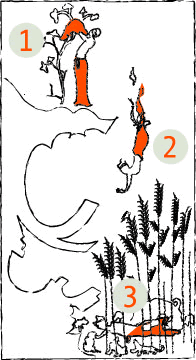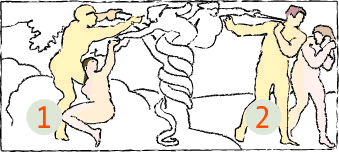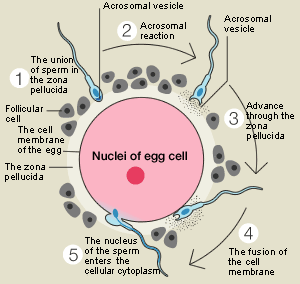 |
Tigar j taka / taka /
Asuka period / 7th century / In the collection of Horyu-ji Temple
(Photograph: Nara National Museum)
This work depicts a j taka (a tale depicting one of the Buddha's previous lives), who in a previous life was moved to pity a starving tiger and its cub. He saved them by offering them his own body. The work is drawn in three stages: Hanging his clothes on a tree at the top of a cliff (upper), throwing himself off the cliff (center), and being eaten by the tigers (lower). taka (a tale depicting one of the Buddha's previous lives), who in a previous life was moved to pity a starving tiger and its cub. He saved them by offering them his own body. The work is drawn in three stages: Hanging his clothes on a tree at the top of a cliff (upper), throwing himself off the cliff (center), and being eaten by the tigers (lower). |
|
The method of iji dozu (the tequnigue of depicting different time period in the same picture) is used to depict the passage of time in one picture. The protagonist of the action appears several times in the picture, with the same background used, and the viewers can limit their considerations to the expression of continuous action. One work that typifies this form is the well-known Shashinshiko. The origin of the motif is a tale of the previous life of the Buddha, which came from India. It is seen in glyphs in India and mural paintings in China, but this is a particularly splendid example of the refined composition of Tamamushi Nozushi. It gives the viewer the impression of witnessing a dramatic instant in slow motion.
The elegant figure with its robe coming loose and falling off is enough to make one forget about the horror of being eaten by a tiger. The spirit of self-sacrifice behind saving the tigerユs life is beautifully expressed. The cliff at the left appears in all the scenes, and the character clearly falls over. The interesting aspect is the recognition of the several figures as one person, and sensing that movement.
Michelangelo, the artistic master of the Italian Renaissance, used the iji dozu technique for the center panel of his impressive ceiling painting in the Sistine Chapel, メThe Fall and the Expulsion from Paradiseモ. In the sense that it depicts the birth of sinful human beings, it is a more jarring, immense scene than メThe Creation of Adamモ. The contrasting structure inserted into the Tree of Knowledge determines crime and punishment, the fall to earth from heaven, and the turning point from happiness to sadness. Thatユs how the work makes use of iji dozu in several instances to create an effect in the painting whose primary subject is a narrative. The completion of the realistic expression eliminates the natural aspects. |


